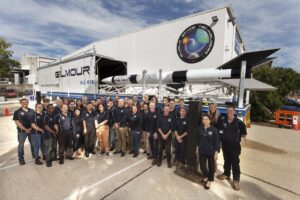Exclusive: Thales Alenia Space on EROSS and Future In-Space Manufacturing
14th May 2024
As the EROSS program prepares to perform its first demonstration mission, Orbital Today sat down with Stéphanie Behar-Lafenêtre, On-Orbit Servicing and Space Logistics Product Development Manager at Thales Alenia Space for an update.
EROSS – or European Robotic Orbital Support Services – is a collaborative program that is working to research and validate the technologies and robotics required for in-space servicing of satellites and other assets.
The program is being led by Thales Alenia Space, a joint-venture between Thales and Leonardo, along with several industry and academic partners including DLR, GMV, PIAP Space, SENER, SINTEF, Space Applications Services, TIPIK, Kongsberg, Trasys, Almatech, and CSEM.
The EROSS program is on track to deliver its inaugural in-space mission by 2027, which will showcase numerous capabilities including satellite rendezvous, capture, docking, refuelling, and payload exchange.
Thales Alenia Space: “The evolution of spacecraft is extremely slow today”
Behar-Lafenêtre told Orbital Today at the inaugural IOSM Conference that the EROSS program intends to reliably deliver on its proven capabilities as soon as its three-month mission is complete.
“The idea is that we would be able to provide the demonstrated capabilities right after the demonstration,” she said. “Yes, it’s great to have a nice technology demonstration, but it’s better to do something with it, so that’s our ambition.”
She went on to explain that the technologies being developed under EROSS could ultimately pave the way for in-orbit manufacturing in the future.
“Technologically speaking, the evolution of spacecraft is extremely slow today, because we cannot upgrade existing assets as easily as we would like,” Behar-Lafenêtre said.
“We imagine that it is possible with the technologies that we will be able to demonstrate on our mission, though we don’t have a timeline for that right now.”
She added that first and foremost, EROSS is looking at existing satellites and spacecraft that are already in-orbit, that weren’t yet constructed with any mechanisms for easily holding or moving them.
“The first thing our project is looking at is existing space assets in orbit that are not prepared – can we reach them, grab them, and move them around? That’s the first step,” she explains.
The future of in-space manufacturing
From there, there is the possibility to extend the life of these assets, by opening the door to in-orbit servicing, she said. “In particular, geostationary telecom operators, for instance, are extremely interested and expecting to be able to maintain their satellites in orbit for longer than originally intended.”
However, she believes this market, while it will arise first, “will not last very long”, due to the way new space assets are constructed. “The idea is that we will be able to prepare the next generation of space assets, to be more flexible. They will be equipped with interfaces that will allow them to be updated or removed and replaced with a new more up-to-date version, in the event of failure or simply to benefit from new updated technology developed on the ground.”
Behar-Lafenêtre said we will begin to see the use of such technologies by 2030, however, the timeline for the next step to this process – assets assembled entirely in space – is harder to pinpoint.
“We have to completely change how we design and build space assets, if we were to ever only send up parts to be assembled together, that would ultimately become a new satellite or spacecraft. We’re working on the capabilities that will ultimately lead to that as a possibility.”
According to Behar-Lafenêtre, there are many benefits to altering or manufacturing, specifically space assets, in space.
“Firstly, there is the sustainability aspect. If we can alter existing systems and extend their lifespan, that avoids the need to send a new object into orbit,” she said.
“If we can move to full assembly in space, then we can avoid waste as a maximum,” Behar-Lafenêtre said, adding that we could see a future in which parts of old space assets are removed and re-purposed to be used in new assets.
“All of these technologies are working towards reducing waste in space and avoiding a big junkyard. We must be reasonable and sustainable in our business up there.”







Thank you for your comment! It will be visible on the site after moderation.